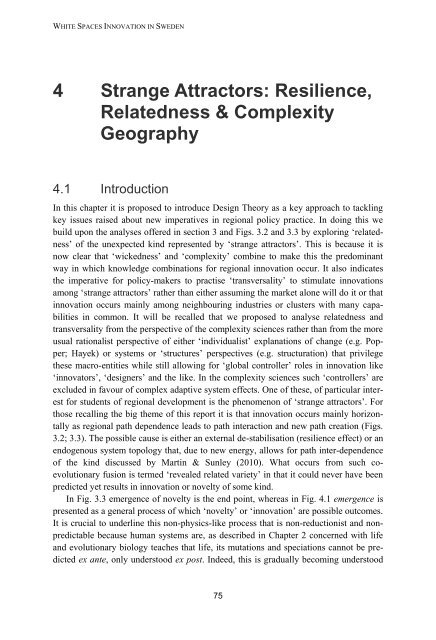White Spaces Innovation in Sweden - Innovation policy for ... - Vinnova
White Spaces Innovation in Sweden - Innovation policy for ... - Vinnova
White Spaces Innovation in Sweden - Innovation policy for ... - Vinnova
Create successful ePaper yourself
Turn your PDF publications into a flip-book with our unique Google optimized e-Paper software.
WHITE SPACES INNOVATION IN SWEDEN4 Strange Attractors: Resilience,Relatedness & ComplexityGeography4.1 IntroductionIn this chapter it is proposed to <strong>in</strong>troduce Design Theory as a key approach to tackl<strong>in</strong>gkey issues raised about new imperatives <strong>in</strong> regional <strong>policy</strong> practice. In do<strong>in</strong>g this webuild upon the analyses offered <strong>in</strong> section 3 and Figs. 3.2 and 3.3 by explor<strong>in</strong>g „relatedness‟of the unexpected k<strong>in</strong>d represented by „strange attractors‟. This is because it isnow clear that „wickedness‟ and „complexity‟ comb<strong>in</strong>e to make this the predom<strong>in</strong>antway <strong>in</strong> which knowledge comb<strong>in</strong>ations <strong>for</strong> regional <strong>in</strong>novation occur. It also <strong>in</strong>dicatesthe imperative <strong>for</strong> <strong>policy</strong>-makers to practise „transversality‟ to stimulate <strong>in</strong>novationsamong „strange attractors‟ rather than either assum<strong>in</strong>g the market alone will do it or that<strong>in</strong>novation occurs ma<strong>in</strong>ly among neighbour<strong>in</strong>g <strong>in</strong>dustries or clusters with many capabilities<strong>in</strong> common. It will be recalled that we proposed to analyse relatedness andtransversality from the perspective of the complexity sciences rather than from the moreusual rationalist perspective of either „<strong>in</strong>dividualist‟ explanations of change (e.g. Popper;Hayek) or systems or „structures‟ perspectives (e.g. structuration) that privilegethese macro-entities while still allow<strong>in</strong>g <strong>for</strong> „global controller‟ roles <strong>in</strong> <strong>in</strong>novation like„<strong>in</strong>novators‟, „designers‟ and the like. In the complexity sciences such „controllers‟ areexcluded <strong>in</strong> favour of complex adaptive system effects. One of these, of particular <strong>in</strong>terest<strong>for</strong> students of regional development is the phenomenon of „strange attractors‟. Forthose recall<strong>in</strong>g the big theme of this report it is that <strong>in</strong>novation occurs ma<strong>in</strong>ly horizontallyas regional path dependence leads to path <strong>in</strong>teraction and new path creation (Figs.3.2; 3.3). The possible cause is either an external de-stabilisation (resilience effect) or anendogenous system topology that, due to new energy, allows <strong>for</strong> path <strong>in</strong>ter-dependenceof the k<strong>in</strong>d discussed by Mart<strong>in</strong> & Sunley (2010). What occurs from such coevolutionaryfusion is termed „revealed related variety‟ <strong>in</strong> that it could never have beenpredicted yet results <strong>in</strong> <strong>in</strong>novation or novelty of some k<strong>in</strong>d.In Fig. 3.3 emergence of novelty is the end po<strong>in</strong>t, whereas <strong>in</strong> Fig. 4.1 emergence ispresented as a general process of which „novelty‟ or „<strong>in</strong>novation‟ are possible outcomes.It is crucial to underl<strong>in</strong>e this non-physics-like process that is non-reductionist and nonpredictablebecause human systems are, as described <strong>in</strong> Chapter 2 concerned with lifeand evolutionary biology teaches that life, its mutations and speciations cannot be predictedex ante, only understood ex post. Indeed, this is gradually becom<strong>in</strong>g understood75
















